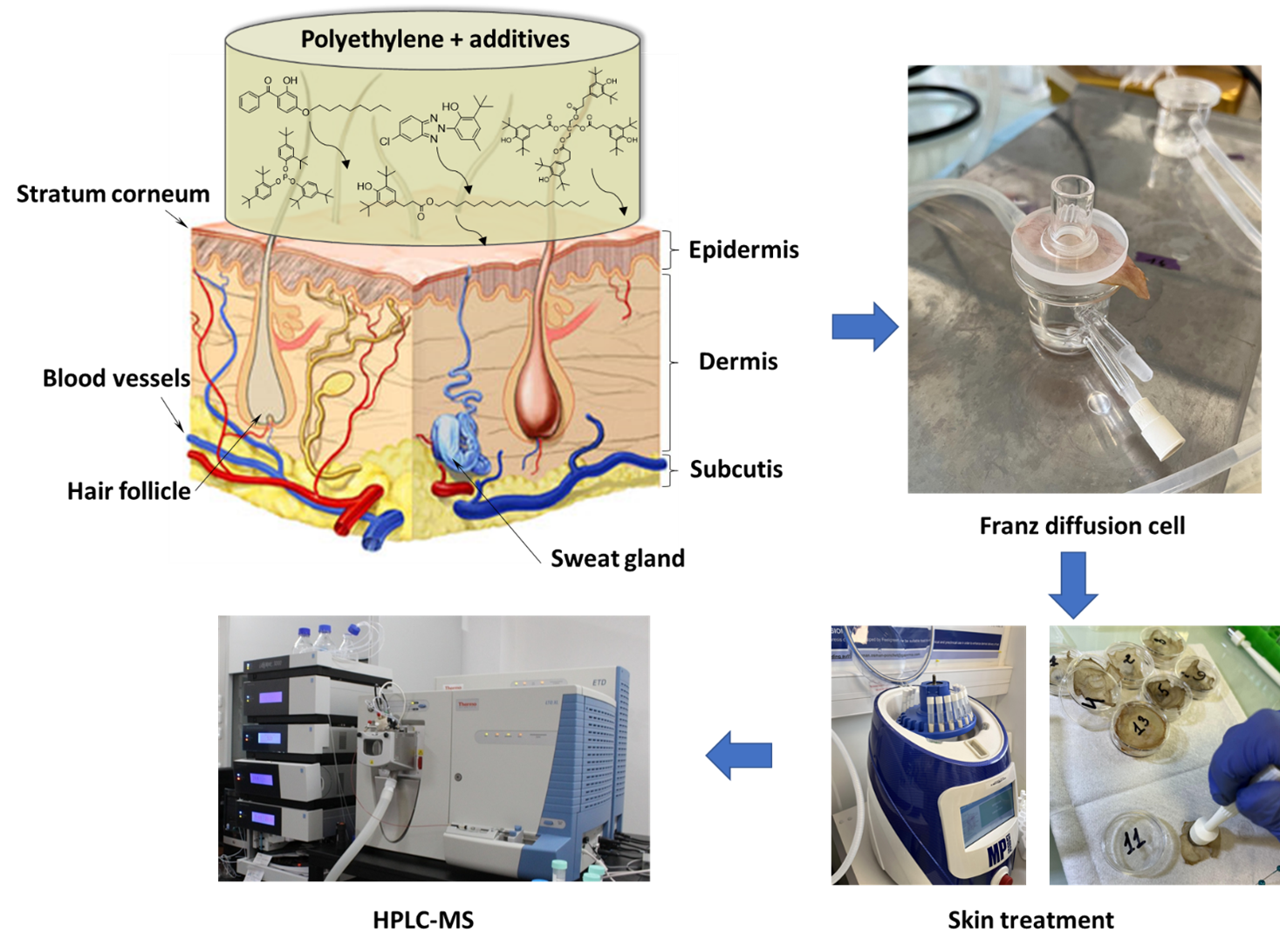Academy of Excellence "Space, Environment, Risk and Resilience"
Proof of concept: potential migration of plastic additives through human skin
- P. NAVARD -
Assessing how plastic additives might migrate through skin. Can additives of plastics migrate through human skin?

Academy 3 highlight
This project falls under the topic “Assessing and sensing anthropogenic hazards to human health, environments and global changes.” We have been investigating potential future solutions to decrease the health risk of plastic additives by observing additive migration through the skin, gaining a scientific understanding of the process and anticipating its consequences and hazards.
The project
Everyone is currently aware that plastics contain additives that may be harmful. These additives, organic molecules mixed with polymers to enhance their properties, have raised concerns. Over 2,400 of them have been found to be potentially harmful for the environment and human health. Only one research article has been published showing that additives can migrate into human skin. The objective of this project is to re-explore the issue by placing a piece of plastic in contact with human skin. The originality of this work is the full control of the composition of the plastic. A low-density polyethylene was chosen because it is one of the most common plastic materials. Five very common additives (at 1% concentration) were added to polyethylene in an internal mixer, then shaped into discs. The additives were two primary antioxidants (Irganox 1010: sterically hindered primary phenolic; Irganox 1076: sterically hindered primary phenolic), one secondary antioxidant of phosphite class (Irgafos 168) and two UV protectors (UV 326: hydroxyphenyl benzotriazole class; Chimassorb 81: 2-hydroxy-benzophenone class). The size of the plastic disc was compatible with Franz diffusion cells and the disc was placed in contact with human skin at 37°C for 24 hours. After 24 hours, the skin that had been in contact with the plastic disc was removed and it was investigated whether the additives present in the plastic disk were present in the skin. To measure this, the additives were extracted from the skin and analyzed using HPLC-MS. The results show the presence of additives in all extracts and confirm their ability to penetrate the skin tissue in the short term. Additives with low mass and high lipophilicity had the highest concentration in the skin.
It was found that about 0.8 % of the additives migrated into the skin from the PE disc within 24 hours. This may be explained by the fact that polyethylene contains a non-crystalline fraction which is highly mobile, since its glass transition temperature (-100°C) is well below body temperature.
This an essential finding, since humans are always in contact with plastic materials touching their skin. This study has provided valuable insights into the potential health risks associated with prolonged skin interaction with plastic materials, particularly for people who handle them extensively. The use of both physico-chemical and biological methods shows the multidisciplinary nature of the project.
It was found that about 0.8 % of the additives migrated into the skin from the PE disc within 24 hours. This may be explained by the fact that polyethylene contains a non-crystalline fraction which is highly mobile, since its glass transition temperature (-100°C) is well below body temperature.
This an essential finding, since humans are always in contact with plastic materials touching their skin. This study has provided valuable insights into the potential health risks associated with prolonged skin interaction with plastic materials, particularly for people who handle them extensively. The use of both physico-chemical and biological methods shows the multidisciplinary nature of the project.
The +
We demonstrated that common additives of low molar mass found in everyday polyethylene products can migrate through human skin upon contact.
What’s next?
This project has demonstrated that additives found in plastics migrate through human skin. This work was performed using a home-compounded polyethylene plastic disk. The next steps will be to look at additive penetration in the skin using commercial products such as clothes, computer mice or steering wheels.
Project information
|
Scientific domain
Chemistry, Biology, Human Health |
Key words Plastics Additives Migration Human skin |
|
Total budget
€7,000 from Academy 3
|
Students involved
Veronika Khodyrieva (Phd) Pauline Germain-Durandy (Master) |
| Partners CEMEF - Mines-Paris, CNRS ICN - Université Côte d’Azur, CNRS PKDerm |
Project members Patrick Navard Alice Mija Véronique Michelet Hanan Osman-Ponchet |

Patrick Navard
CEMEF - Mines-Paris, CNRS
Scientific promotion of the project
- V. KHODYRIEVA, C. COMBEAUD, P. NAVARD, A. MIJA, V. MICHELET, S. OLIVERO, P. GERMAIN-DURANDY, L. PERDIGON, H. OSMAN-PONCHET: "Environmental and health risk assessments of additives polyethylene plastics", Polychar World Forum on Advanced Materials 2023, Nice, France, September 25-29, 2023
- J. HIENNE, R. COLPAERT R, D. RIEFFEL, P. NAVARD, V. KHODYRIEVA, A. de VAUFLEURY et F. GIMBERT : "Évaluation de la toxicité des microplastiques dans les sols pour l’escargot : Rôle des additifs", Colloque de la Société d’Écotoxicologie Fondamentale et Appliquée (SEFA 2023), Le Havre, July 5-6, 2023
- V. KHODYRIEVA, C. COMBEAUD, P. NAVARD, A. MIJA, V. MICHELET, S. OLIVERO, P. GERMAIN-DURANTY, H. OSMAN-PONCHET et L. PERDIGON : "Environmental and health risk assessments of additives in polyethylene plastics", 50th Polymer Study Days (Journées d'Etudes des Polymères - JEPO), Le Val Joly, October 8-13, 2023
- P. NAVARD, V. KHODYRIEVA, C. COMBEAUD, A. MIJA, V. MICHELET, S. OLIVERO, P. GERMAIN-DURANDY, L. PERDIGON, H. OSMAN-PONCHET et T. FAHLER: "Health and environmental assessment of a single well-controlled polyethylene plastic" ACS Spring 2024, New-Orleans (USA), March 17-21, 2024

















